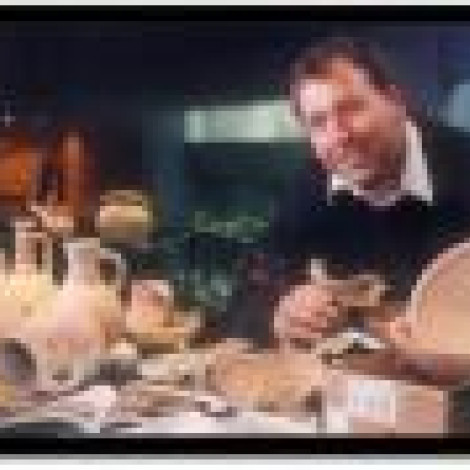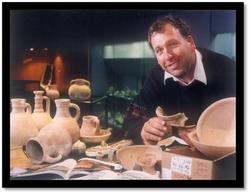
Prof. Hanan Eshel
CV
Prof. Hanan Eshel (1958-2010)
|
Prof. Hanan Eshel passed away on April 8, 2010, at the age of 51, after a long battle with cancer. He was buried the same day at Kibbutz Maʽale Hahamisha. Hanan is survived by his mother Shulamit, his wife Esther, a son, a daughter, and three grandchildren. Hanan was born in Rehovot on July 25, 1958. He attended the Or ʽEtzion yeshiva high school and performed his military service from 1977 to 1980, where he met Esther, his future wife. The two were married at Keshet, on the Golan Heights, and moved to Ofra about a year later. Hanan worked there as an instructor in the field school until 1988. In addition, in 1982 he started studying archaeology and Jewish history at the Hebrew University of Jerusalem, where he earned his bachelor's and master's degrees magna cum laude. He wrote his master's thesis on the presumed construction of temples to the God of Israel in Bethel and Samaria after the destruction of the First Temple (under the supervision of Prof. Israel Ephʽal), and his doctoral dissertation, submitted in 1994, on the Samaritans in the Persian and Hellenistic periods (under the supervision of Prof. Ephʽal and Prof. Daniel Schwartz). After a year as a postdoctoral fellow and guest lecturer at Harvard University, Hanan was appointed a senior lecturer in the Martin (Szusz) Department of Land of Israel Studies and Archaeology at Bar-Ilan University in 1996, and within just three years he was named an associate professor. He chaired the department from 2002 to 2004, and shortly before his death was promoted to full professor. Along with his devotion to research and his scholarly accomplishments, which earned him such rapid advancement at the university, Hanan held several public positions. He chaired the Jeselsohn Epigraphic Center of Jewish History at Bar-Ilan University and was a member of the editorial boards of Yad Ben-Zvi and the Israel Numismatic Journal, the board of the Israel Exploration Society, and the Government Names Committee. Hanan was a world-renowned expert in the archaeology and history of the First and Second Temple periods. His research interests included the Dead Sea Scrolls, the settlement at Qumran, the Bar Kokhba Revolt, numismatics, and historical geography. He excavated the refuge caves on Ketef Jericho (with Boaz Zissu), where he discovered documents from the Persian period and Bar Kokhba period. His excavations of the "Selʽa Cave"(the cave of the Tetradrachm) in the upper portion of Nahal Hever (with David Amit) uncovered the first silver sela (tetradrachm) of Bar Kokhba ever found in archaeological excavations. He also excavated Khirbet Yattir in the southern Hebron Hills (with Jodi Magness and Eli Shenhav), where a church was discovered containing a rare mosaic with magical symbols. A survey by Hanan (and Boaz Zissu) in the el-Jai Cave in Nahal Mikhmash revealed coins of Aelia Capitolina and Bar Kokhba coins-possible evidence that the Roman city was founded even before the revolt. In recent years he headed research expeditions to Qumran (with Magen Broshi), excavated refuge caves in the Ein Gedi area (with Roi Porat and others), and oversaw a survey of the caves along the fault cliff between Qumran and Ein Gedi (with Amos Frumkin). A prolific author and intellectually gifted scholar, Hanan wrote and edited several books and published more than 200 papers. His books include The Dead Sea Scrolls and the Hasmonean State (in Hebrew and English), Refuge Caves of the Bar Kokhba Revolt (two volumes, the second of which, written together with Roi Porat, was published exactly two months before his passing), and The Hasmonean Period: Collection of Articles (with David Amit). In the last year of his life, during which he worked tirelessly despite his failing health, Hanan also wrote field guides to Masada, Qumran, and Ein Gedi (published by Carta in Hebrew and English). He edited and published several of his most prominent research studies together with his faithful wife and partner, Dr. Esther Eshel, a renowned paleographer and epigraphist and a lecturer in the Department of Bible at Bar-Ilan University. Hanan was blessed with many diverse traits and talents: a brilliant memory and quick grasp of issues, exceptional intuition and the ability to focus on what is really important, a love of books and love of fieldwork, diligence and boundless ambition, and a tremendous ability to work. But he was also gifted with other rare qualities: he was a good friend and a superb teacher who was attentive to his students' needs. Hanan cared about his students, and he knew how to help them progress and bring them-sometimes forcibly-to the finish line. Many of his colleagues and students know full well that it is thanks to Hanan that they have come as far as they have in their academic careers. Hanan's accomplishments and expertise in the study of the Dead Sea Scrolls were attained by dint of scientific curiosity, an ability to combine different fields of research, and innate intuition. Indeed, very quickly Hanan became a leading member of the large, solidly established international community of Dead Sea Scrolls scholars. In the introduction to his book on the Scrolls and the Hasmonean state, Hanan tells of an incident that occurred in 1987, when he was just getting started as a scholar of the Scrolls. At an academic conference marking the 40th anniversary of the discovery of the first Dead Sea Scrolls, he realized that there was a sharp divide between experts on the Scrolls and archaeologists. Because he was already in both worlds, Hanan took on a task that he described as follows: "to bring the Qumran scholars up to date on archaeological discoveries, and to tell the archaeologists what the Scrolls say." Hanan devoted much of his time in the 23 years since then to this dual mission. They were years of fruitful, innovative scholarly work on the Scrolls and on the Bar Kokhba Revolt. Another outstanding example of Hanan's intuition could be heard in his last lecture-at an archaeological congress held at Ben-Gurion University, in a session marking the 50th anniversary of Operation Judean Desert. With superhuman determination, Hanan got up from his sickbed for the congress, just two weeks before his death. Friends transcribed his lecture and he managed to edit it and have the pleasure in his last days of seeing it ready for press. The text was printed in the culture and literature supplement of the daily newspaper Ha'aretz the day after his passing. It reads like a fascinating scientific detective story about passages from the book of Numbers and passages contained in tefillin, involving archaeologists, Bedouin, and a bearded vulture-a desert bird of prey that took care of its offspring by upholstering its nest with torn bits of parchment. |
|
Boaz Zissu & David Amit |
Last Updated Date : 13/07/2022





